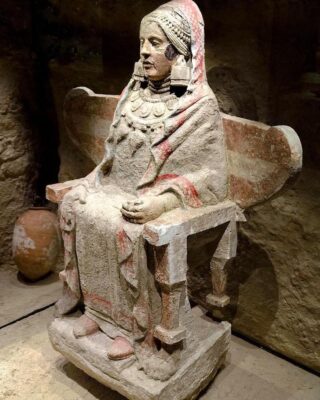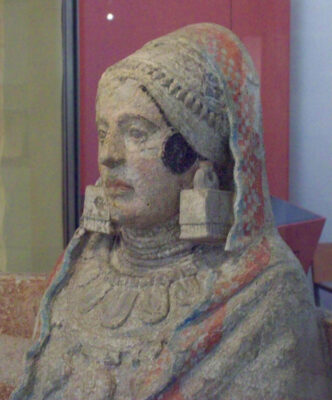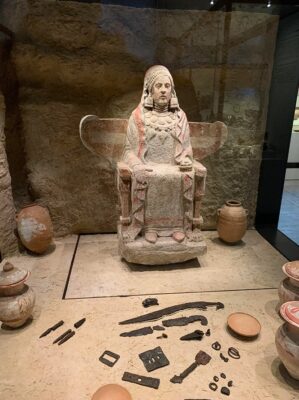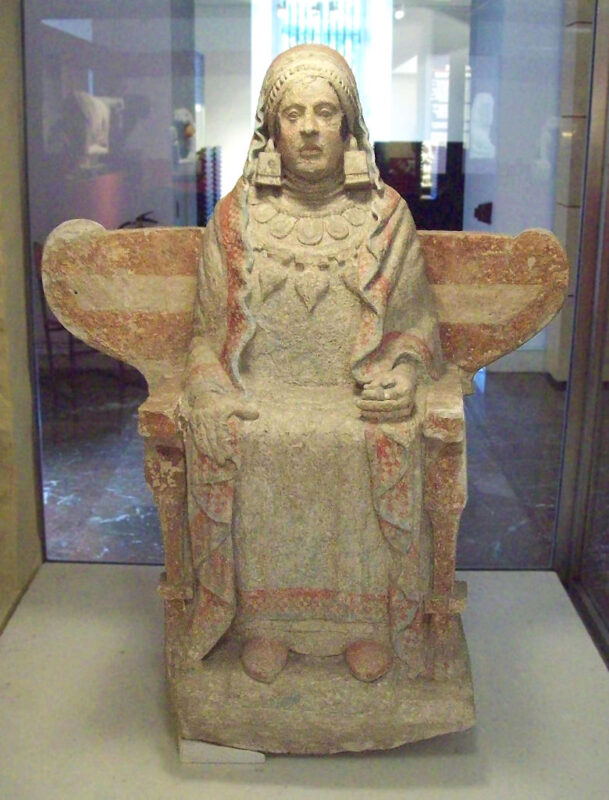The Lady of Baza is a fascinating ancient sculpture that carries immense historical and artistic significance. Discovered on July 22, 1971, by archaeologist Francisco José Presedo Velo, the statue was found during an excavation at the Baza necropolis, near Granada, Spain. Dating back to the 4th century BC, the statue is believed to depict a Celtiberian figure from Bastetani, whose capital was located nearby.
Follow archeology.dulichvn.net to discover many hidden mysteries that have yet to be discovered.

1. The Discovery of Lady of Baza
1.1 The Discovery of the Lady of Baza
In July 1971, the Lady of Baza was uncovered by the renowned Spanish archaeologist Francisco José Presedo Velo during an excavation at the Baza necropolis, located near Granada, Spain. This remarkable discovery revealed more than just a statue—it illuminated the rich cultural and artistic heritage of the Celtiberians, specifically the people of Bastetani. Through this find, archaeologists gained valuable insight into the ancient practices, beliefs, and craftsmanship of a civilization that once thrived in the Iberian Peninsula.
1.2 The Statue’s Historical Significance
Dating back to the 4th century BC, the Lady of Baza offers a window into the peak of Celtiberian civilization. This period marked a time of great cultural activity and development, particularly within the Iberian Peninsula. The statue stands as an exceptional representation of the artistic and religious practices of the Bastetani people. More than just an exquisite work of art, the Lady of Baza provides significant evidence of the region’s burial traditions and spiritual beliefs, shedding light on the societal norms and customs of ancient Iberia.
1.3 A Symbol of Iberian Art and Culture
Among the most important discoveries of ancient Spanish art, the Lady of Baza is considered one of the most outstanding sculptures from the Celtiberian period. Along with the Lady of Elche, this piece has become an iconic symbol of Iberian culture and art. Its intricate design and sophisticated craftsmanship continue to captivate historians, archaeologists, and art enthusiasts worldwide. The Lady of Baza, with its majestic and detailed features, has earned its place as a timeless representation of ancient Iberian artistry, offering a lasting legacy of the region’s creative spirit.

2. Artistic Features and Intricate Design
2.1 A Majestic Representation
The Lady of Baza is a powerful and dignified depiction of a female figure seated gracefully on a throne, her hands resting gently on her knees in a serene and composed posture. The artist’s meticulous attention to detail, from the fine sculpting of her facial features to the elegant arrangement of her body, conveys a sense of royal stature and grace. The posture and expression of the statue suggest a figure of great importance, radiating authority and reverence.
2.2 Exquisite Accessories of Status
The statue’s regal appearance is further enhanced by the intricate accessories she wears. A finely crafted headpiece crowns her head, complemented by a striking crown and large, ornate earrings. These accessories are not merely decorative; they symbolize the high status and prestige of the figure depicted, emphasizing her noble position within society. The careful design and craftsmanship of these adornments reflect the advanced artistry of the Celtiberian people, while also providing insight into their social hierarchies and cultural values.
2.3 Vibrant Traces of Polychrome
One of the most intriguing aspects of the Lady of Baza is the visible traces of polychrome paint still discernible on the surface of the sculpture. These remnants suggest that the statue was once vibrantly colored, revealing a dynamic and colorful visual aesthetic that was characteristic of Celtiberian art. The preservation of these pigments offers a rare glimpse into the ancient practice of painting sculptures, showcasing the artistic richness and attention to detail that the Celtiberians applied to their artistic creations. The bright colors, now faded but still present, further enhance the statue’s regal appearance, reflecting the lively and rich artistic traditions of the period.

3. Historical and Cultural Valu
3.1 A Reflection of Religious and Cultural Beliefs
The Lady of Baza is widely believed to hold significant ties to the religious beliefs and burial practices of the Bastetani, a Celtiberian tribe. Given its majestic portrayal and the context of its discovery, the statue is thought to represent either a goddess or an influential figure within the Celtiberian social and religious hierarchy. It likely played a role in rituals or ceremonies associated with death, divinity, or royalty, serving as a symbolic guardian or a tribute to an important deity. This interpretation underscores the spiritual importance the figure held in the culture of the Bastetani people.
3.2 A Cultural Snapshot of Celtiberian Society
More than just a religious icon, the Lady of Baza offers a detailed cultural snapshot of the Celtiberian civilization. Through its finely crafted clothing and accessories, the statue provides valuable insights into the fashion and adornment practices of the time. The intricate design of the figure’s crown, earrings, and other adornments reflects not only the wealth and social status of the individual represented but also the artistic techniques of the period. Moreover, the design showcases the cultural exchange between Iberian societies and Mediterranean civilizations, particularly the influence of Greek and Phoenician art. This blending of artistic traditions highlights the interconnectedness of ancient cultures in the region.
3.3 A Monument of Global Significance
Today, the Lady of Baza stands as a treasured artifact, carefully preserved and displayed in Spain as a symbol of the country’s rich cultural heritage. As one of the most remarkable sculptures from ancient Iberia, the statue transcends national borders, offering insights into the religious, cultural, and artistic practices of the Celtiberian people. Its significance extends far beyond Spain, as it continues to inspire scholars and art enthusiasts worldwide, serving as a key object of study in the fields of history, art, and anthropology. The Lady of Baza remains an enduring testament to the sophistication of ancient Iberian societies and their lasting influence on the broader Mediterranean world.
See more: Exploring Saudi Arabia’s Ancient Funerary Avenues: A 4,500-Year-Old Mystery
Conclusion
The Lady of Baza is not just a remarkable work of ancient art but also a symbol of a vibrant and rich historical period. From its exquisite craftsmanship to its deep cultural significance, this statue continues to leave a lasting impact on the history of Spain and the Celtiberian civilization. The existence of the Lady of Baza stands as a powerful testament to the artistic talent and spiritual depth of the people of ancient Iberia.


CÁC TIN KHÁC
Mary Walton: The Forgotten Inventor Who Helped Clean Up America’s Cities
Tomb of Queen Nefertari in the Valley of the Queens, Egypt
Discover the Hypostyle Hall of the Temple of Hathor at Dendera
Venus de Losange: Unveiling the Mystery of a 20,000-Year-Old Paleolithic Icon